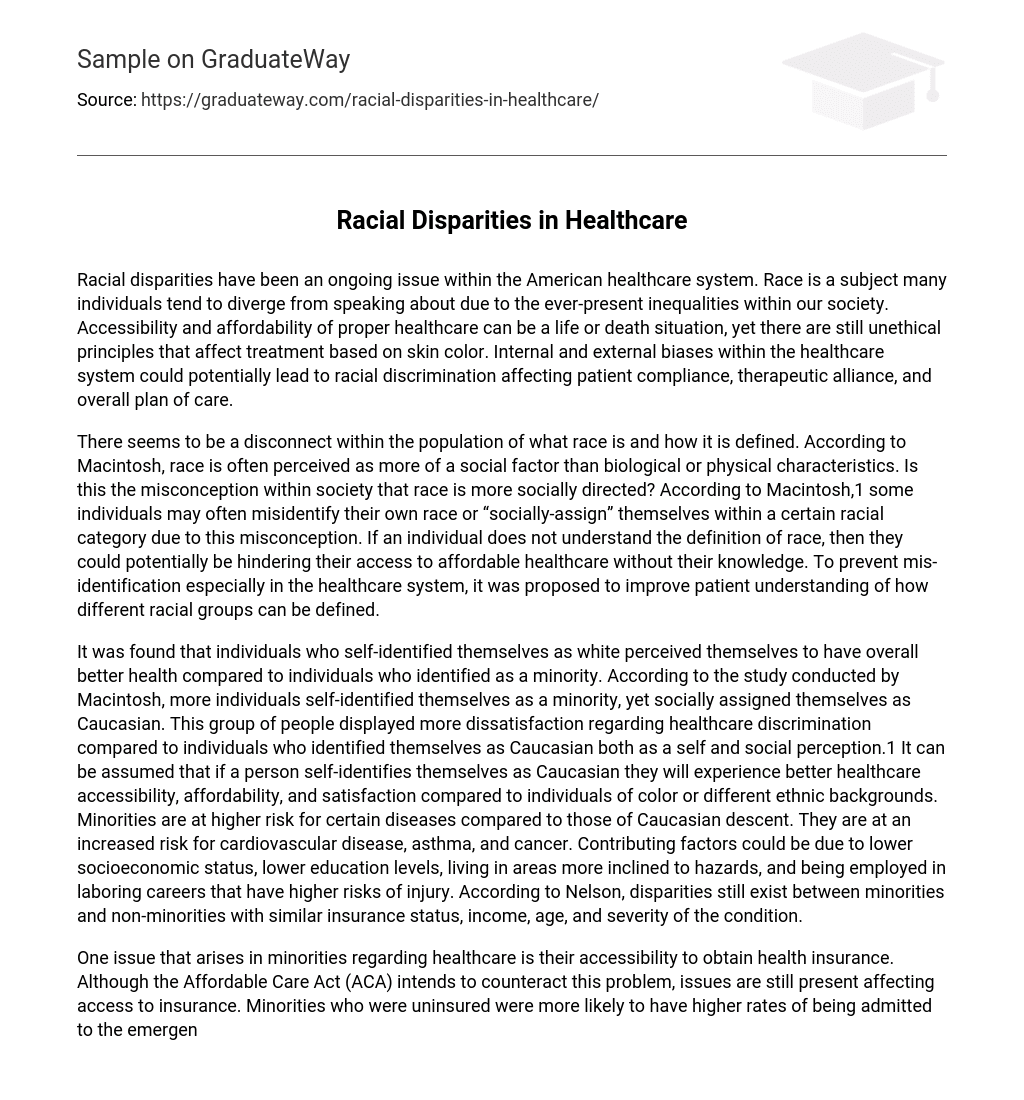Racial disparities have been an ongoing issue within the American healthcare system. Race is a subject many individuals tend to diverge from speaking about due to the ever-present inequalities within our society. Accessibility and affordability of proper healthcare can be a life or death situation, yet there are still unethical principles that affect treatment based on skin color. Internal and external biases within the healthcare system could potentially lead to racial discrimination affecting patient compliance, therapeutic alliance, and overall plan of care.
There seems to be a disconnect within the population of what race is and how it is defined. According to Macintosh, race is often perceived as more of a social factor than biological or physical characteristics. Is this the misconception within society that race is more socially directed? According to Macintosh,1 some individuals may often misidentify their own race or “socially-assign” themselves within a certain racial category due to this misconception. If an individual does not understand the definition of race, then they could potentially be hindering their access to affordable healthcare without their knowledge. To prevent mis-identification especially in the healthcare system, it was proposed to improve patient understanding of how different racial groups can be defined.
It was found that individuals who self-identified themselves as white perceived themselves to have overall better health compared to individuals who identified as a minority. According to the study conducted by Macintosh, more individuals self-identified themselves as a minority, yet socially assigned themselves as Caucasian. This group of people displayed more dissatisfaction regarding healthcare discrimination compared to individuals who identified themselves as Caucasian both as a self and social perception.1 It can be assumed that if a person self-identifies themselves as Caucasian they will experience better healthcare accessibility, affordability, and satisfaction compared to individuals of color or different ethnic backgrounds. Minorities are at higher risk for certain diseases compared to those of Caucasian descent. They are at an increased risk for cardiovascular disease, asthma, and cancer. Contributing factors could be due to lower socioeconomic status, lower education levels, living in areas more inclined to hazards, and being employed in laboring careers that have higher risks of injury. According to Nelson, disparities still exist between minorities and non-minorities with similar insurance status, income, age, and severity of the condition.
One issue that arises in minorities regarding healthcare is their accessibility to obtain health insurance. Although the Affordable Care Act (ACA) intends to counteract this problem, issues are still present affecting access to insurance. Minorities who were uninsured were more likely to have higher rates of being admitted to the emergency department, as well as, having less access to preventative care, prescription medications, and being diagnosed with later-stages of cancer. Prior to passing the ACA, about 25% of African Americans were uninsured due to having a lower-income and having a job with little to no health benefits. Since some African Americans are receiving a lower-income, paying for health insurance can take a toll on families due to its high expense. In addition, if employers are not providing healthcare benefits for them they will most likely be paying an increased rate for insurance coverage. When the ACA was implemented, the goal was to provide subsidies in order to assist those in lower-income households, employees not receiving benefits, and to help individuals afford private insurance.
Cross-sectional studies that were done before the ACA show that coverage is just one aspect of these disparities among minorities. Whether an individual is insured or uninsured, access to healthcare can differ significantly between racial and ethnic groups. Factors that contribute to healthcare access include educational attainment, language barriers, citizenship, and neighborhood. There is also a correlation noted between lower-income families and racial/ethnic minorities. Lower-income families tend to be more supportive of the ACA having reported improved trends in healthcare outcomes compared to higher-income families and/or white adults.16 However, both lower-income families and minorities report higher cost-related barriers, decreased satisfaction with healthcare quality, and difficulty obtaining appointments.
In order to make improvements towards reducing or eliminating racial disparities in healthcare, a better understanding of the barriers needs to be addressed. Appropriate actions need to be taken by more than just the government, but rather unified participation from the government, healthcare organizations, and the community.21 There must be accurate ethnic and racial data collection on the population. The Robert Wood Johnson Foundation comprised several forms regarding healthcare organizations’ usage of obtained data. These forms address the accuracy and availability of census data, under-identification of patients of Hispanic descent, self-identification of race, and the legal and ethical limitations.21 Although these forms offer valuable information, continued research and exploration to obtain data are necessary to decrease racial disparities in healthcare.
Structural and social determinants have been suggested to be involved with race disparity in healthcare. The structural determinant proposes that there are not enough accessible and high-quality healthcare facilities in lower-income and minority communities. Social determinants include inadequate public transportation, substandard housing, decreased availability of healthy food, lack of fitness centers, and supportive measures to live a healthy lifestyle. In conclusion, race does impact accessibility, affordability, and quality of care. To help address these issues wellness programs and pro-bono facilities can be incorporated into the lower-income communities. More attention needs to be focused on improving opportunities for racial minorities to receive adequate care.





